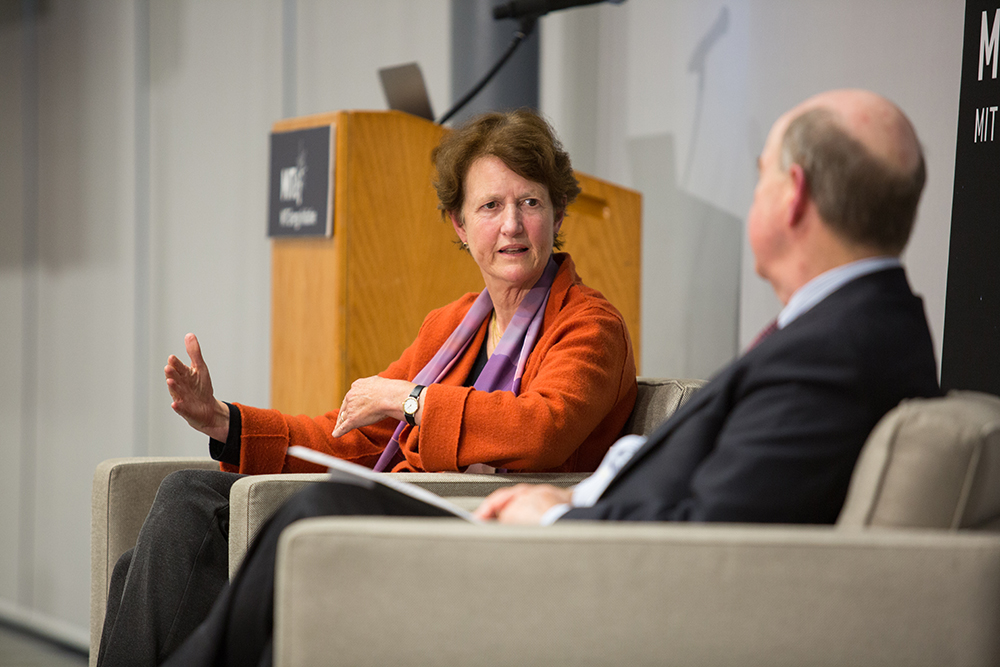
Frances Beinecke, past president of the Natural Resources Defense Council, spoke at the MIT Energy Initiative’s annual Fall Colloquium, addressing topics ranging from the recent climate report by the Intergovernmental Panel on Climate Change (IPCC), to how to create better climate policy, to visions for the future energy transformation.
As she began her talk following an introduction by MITEI Director Robert C. Armstrong, a rainbow across Boston’s skyline was visible out the window. She quipped that the beauty of nature was exactly why she was here—and then she got down to business.
“An unprecedented acceleration of actions is necessary between now and 2030. That is 12 years from now. That is very, very soon,” Beinecke said.
Much of her lecture centered on climate policy, including steps taken by past President Barack Obama. Beinecke said she vividly remembers Obama’s speech at Georgetown University in June 2013, a day so hot that the president’s teleprompter broke. He was announcing numerous new energy policies that day, including the Clean Power Plan.
At the time, Beinecke said, she and other leaders of major environmental organizations believed the federal government was the answer to the climate problem. Now, she feels differently.
“It is about ‘we,’” Beinecke said. “The ‘we’ represents multiple actors. It represents we as individuals, elected officials, mayors, governors, federal leaders, heads of corporations. In every walk of life, we have a role and can take responsibility for this.”
She discussed the IPCC climate report at length, including its finding that a global temperature rise of 1.5 degrees Celcius, rather than 2 degrees, would protect millions of people from some of the most ravaging effects of climate change. At a 1.5 degree increase, 14 percent of the population would experience extreme heat—but at 2 degrees, that number more than doubles to 37 percent.
While acknowledging that this statistic can cause feelings of despair, Beinecke urged audience members to find hope. The state of California, she said, is one example of a possible path forward. It’s the fifth largest economy in the world, and because of its waiver to enact stricter environmental regulations than other states and the federal government, it’s been able to make large strides forward in emissions reductions, clean power sources, and more.
“California’s role here is as a global model,” Beinecke said. “California is big, powerful, and has the resources to experiment with these things—see how they work, get them right, and create models for the rest of us.”
Beinecke said that the power of local communities and companies to determine the climate’s future has never been stronger.
“All of those elements are creating something that we’re starting to call the new climate federalism,” Beinecke said. “Originally, we thought we were going to have a national policy. It’s going the other way now. It’s happening in cities, in states, in corporations. That will weave together and hopefully, in the early 2020s, will translate into a national policy.”
Beyond the power of cities, elected officials, and corporations to advance climate priorities, Beinecke also talked about the impact of public opinion.
She cited a survey by the Yale University Program on Climate Change Communication in March 2018 where 70 percent of respondents were supportive of measures such as regulating carbon dioxide as a pollutant and funding more renewable energy research. The same study found that certainty in the existence of climate change has increased 12 percentage points in the past 3 years, with almost 50 percent of the public “extremely” or “very” sure that climate change is occurring.
During the event, Beinecke and Armstrong discussed the transition to a low-carbon energy future, highlighting power and transportation as two sectors that have made significant progress. Given the federal research & development funding for energy is at an all-time high, Armstrong zeroed in on where researchers should be investing that money: “What do you see as the big challenges to attack in power and transportation?”
Beinecke answered simply: Technology moves rapidly, and the challenge is keeping up.
“[We need to be] looking at both what’s going to be an aid to the transformation, and also what could be a block. What could create a barrier, that—if we could identify it early—wouldn’t have to be overcome later?”
As part of the solution, Beinecke also talked about innovation, and specifically, innovation at MIT.
“I always find coming to MIT incredibly inspiring, because there’s the best and the brightest trying to address some of the most serious issues facing all of us,” Beinecke said. “I appreciate all that you do and all that you will do because we need it.”
This article appears in the Spring 2019 issue of Energy Futures.